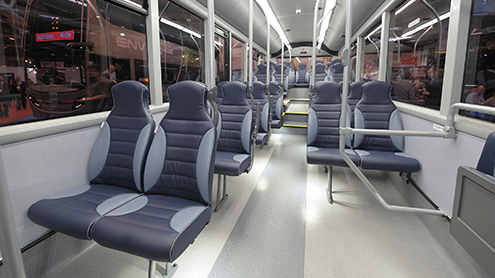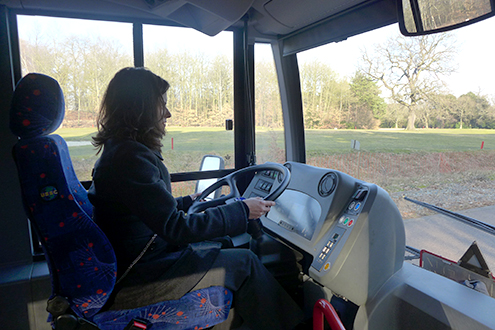

Prototype to be unveiled at APTA Bus and Paratransit conference in Indianapolis, IN
By Doug Jack
Alexander Dennis (AD) is one of the fastest growing bus builders in the western world. Since Chief Executive Officer Colin Robertson took the helm in 2007, earnings have risen from $250 million in his first year to more than $700 million last year. He has led the company toward new product development, closer relationships with customers and dynamic expansion of its export activities.
Alexander Dennis and New Flyer have decided to brand their latest joint venture as the MiDi bus. I was impressed with the amount of work that has already gone into the project. The two companies are set to launch the MiDi bus in May at the APTA Bus and Paratransit conference in Indianapolis, IN, as well as several other transit and shuttle conferences in North America throughout 2013.
I began by asking Robertson how it all came about.
“Toward the end of 2010 we had a management meeting,” he says. “We were already supplying double deck buses to North America and wanted to sell our popular midibuses there as well. We could either do it alone in fairly small numbers or talk to the best potential partner to achieve higher volumes.”
Early in 2011, Robertson and AD Commercial Director Robert Davey flew to Winnipeg, MB, Canada, to meet with New Flyer President and CEO Paul Soubry and Paul Smith, EVP sales and marketing.
“We gave them a presentation about our Enviro200 midibus range and found that they had made their own strategic review to consider the development of a lighter bus range to complement their heavy-duty transit buses,” says Robertson. “We got on well and soon decided that if New Flyer took on the Enviro200 and built it in North America we would achieve much higher potential volumes and easily meet Buy-America rules. For New Flyer the attraction of taking on a proven design was the opportunity to significantly reduce development costs and the time to the market.”
 New Flyer will offer the Enviro200 at two overall lengths — 30 and 35 feet. The Cummins ISBe 6.7 liter engine meets EPA13 standards and couples to the automatic Allison gearbox. DANA supplies the front and rear axles. Thermo King air conditioning is standard. All of these units are obtainable in the United States.
New Flyer will offer the Enviro200 at two overall lengths — 30 and 35 feet. The Cummins ISBe 6.7 liter engine meets EPA13 standards and couples to the automatic Allison gearbox. DANA supplies the front and rear axles. Thermo King air conditioning is standard. All of these units are obtainable in the United States.
The vehicle has a double-width entrance ahead of the front axle with a wheelchair ramp. Two wheelchair locations immediately behind the front wheelboxes feature tip-up seats when the space is not required.
The floor in the front half of the vehicle is 12 inches above the ground and can kneel to curb level.
Alexander Dennis will deliver the fully built prototypes from the United Kingdom. New Flyer will establish an assembly line for MiDi buses in St Cloud, MN, where the plan is to start volume production in the fourth quarter of this year.
Although AD has supplied buses in kit form for assembly in Hong Kong and more recently in New Zealand, the New Flyer venture is quite different. Using North American sources to supply the materials and components not only ensures the desired quality, but parts and service support as well. However, AD may have to initially supply some parts from the UK.
Teams from New Flyer and AD are working in parallel across design, production engineering, purchasing and engineering support.

I asked Jennifer McNeill, AD director of sales and business development, to explain the main challenges on the project.
“Moving the steering wheel,” she says. “The teams have been cross-checking regulations between European requirements and Federal Motor Vehicle Safety Standards. Therefore, although the basic structure is pure Alexander Dennis design, there are important alterations like emergency windows, U.S. standard external lighting and vertical roof-level exhaust discharge.”
Talking about how New Flyer plans to position the MiDi bus in the North American market, McNeil says this product is quite different from the full-size transit buses and cutaways. She thinks some existing public customers will be attracted to the MiDi bus because of its accessibility, manoeuvrability and fuel economy.
McNeil thinks the shorter vehicle also has potential at larger airports where van conversions shuttle between hotels and terminals. Such is the case at London Heathrow where Enviro200 buses now run on regular routes, serving several hotels on each journey.
McNeill says the New Flyer sales team will promote the MiDi bus direct to existing public transit authorities, with selected dealers promoting the MiDi bus with potential private customers. She says that while the MiDi bus will carry the New Flyer name, its promotion would be quite different from the existing heavy-duty range.
After our meeting, we drove a few miles north of Guildford to Chobham to visit a major automotive test center with high-speed circuits, rough road surfaces and steep test gradients. We boarded a prototype North American Enviro200 carrying Alexander Dennis and New Flyer staff and made a number of circuits of the track.
The front axle has four-bag air suspension, compared with the standard British specification of two bags and that was a noticeable improvement. The lively Cummins engine was audible but not intrusive, while the shifts in the Allison transmission were smooth. Climbing a 20 percent test gradient prompted one comedian in the group to suggest the bus would sell well in San Francisco.
The prototype MiDi we rode will soon be shipped across the Atlantic to go through an Altoona 10-year, 350,000-mile test program. The decision to opt for the 10-year test was to differentiate the midibuses from heavy-duty transit buses, although the Enviro200 is capable of a longer life than 10 years.
Midibuses have become very popular in the United Kingdom. Bus companies have many routes that do not generate the numbers of passengers needed for heavy-duty single deck or double deck buses. In some cases, midibuses provide services that are more frequent. If passengers can rely on a bus arriving every ten minutes or less, they do not need a timetable.
Midibuses can also go into residential areas that are too restrictive for full size buses, such as the London suburbs. They often feed into the underground rail network and serve long-term parking facilities at our main airports as well as hotels.
While initial price is still important to bus companies over here, they are increasingly focusing on whole-life operating costs. This is where the Enviro200 scores very well, using premium components well supported in the aftermarket.
The patented Alexander aluminium body construction has been around for many years. It’s stood up to very demanding operations, such as around-the-clock service in 40-foot double-deck buses in Hong Kong. The structure is easy to repair and fully recyclable at the end of life. The two companies see great potential for this new MiDi bus in North America, built and backed by New Flyer through proven service, support, spare parts, training and warranty infrastructure.
The final word from Colin Robertson: “If we can take 10 percent of the cutaway market, we will be very happy.” BR
Doug Jack is with Transport Resources in the United Kingdom.
